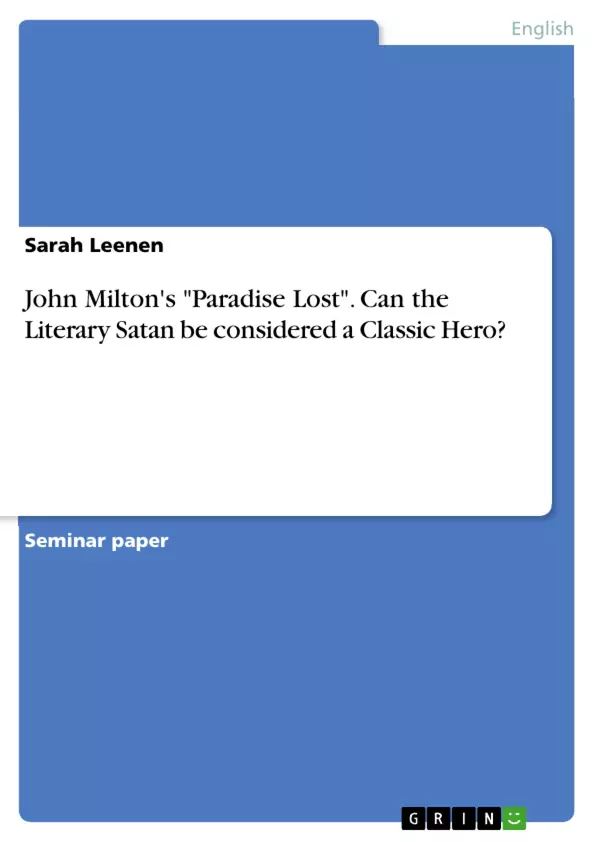This essay analyzes the character of Satan in John Milton's epic "Paradise Lost" and discusses the question whether he might be considered a classic hero.
Paradise Lost, John Milton’s religious epic, has astounded and fascinated readers throughout time and as such may be one of the most highly discussed examples of English literature within living memory. The controversy of Paradise Lost began with its publication in 1674 by John Milton during the time of the Interregnum in England, and even nowadays its subject remains an essential fixture in Western literary canon as well as an important source of inspiration for numerous scholars and artists. Therefore it is interesting to analyze the reasons why a literary work that has been written more than three centuries ago, continues to be the topic and the central cause for scholars’ debate and countless essays and interpretations.
One of the most significant reasons may be the different manners of interpretation, as several aspects may come into focus, while reading Paradise Lost. Determined the counterpart of God, Satan is commonly described as the embodiment of evil. Nevertheless, Milton presents the character depth of his protagonist, so that questions of Satan being a heroic figure arise. In consideration of Satan’s character traits, his downfall from an archangel of heaven to the prince of hell and lastly to the tempter of mankind as illustrated in Paradise Lost should be analyzed.
As the historical reading is a further way of interpreting Paradise Lost, parallels between Satan and historical personalities of the British Revolution, namely Oliver Cromwell and Charles I, are examined. Furthermore the importance of fate in contrast to the belief of free will considering Satan’s attitude is put into focus. In order to compare Satan’s characteristics with those of a classical hero, it is necessary to give a brief definition of the classical hero firstly. In terms of the concept of heroism, Aristotle’s concept of tragedy, especially his definition of hamartia which refers to the tragic flaw of ancient heroes and is hence connected with the idea of the classical hero, serves as an important source. Due to these aspects, a conclusion whether the literary Satan can be regarded as a classical hero can be drawn.
Table of Contents
- Introduction
- The character of Satan in John Milton's Paradise Lost.
- The Archangel of Heaven
- The Prince of Hell
- The Tempter of Mankind
- Parallels between Satan and historical persons
- The importance of fate considering Satan's attitude
- The definition of the classical hero
- A Comparison between Satan and the classical hero.
- Conclusion
Objectives and Key Themes
This text aims to analyze the character of Satan in John Milton's Paradise Lost, exploring his transformation from an Archangel to the Prince of Hell and ultimately the Tempter of Mankind. It also examines the significance of fate and free will in shaping Satan's actions and whether he can be considered a classical hero.
- Satan's multifaceted character and its evolution
- The interplay between Satan's ambition, pride, and downfall
- The significance of fate and free will in shaping Satan's choices
- Comparison between Satan and the classical hero
- Analysis of Satan's motivations and actions in the context of the epic narrative
Chapter Summaries
The introduction provides a brief overview of Paradise Lost and its enduring relevance. It highlights the controversy surrounding the work and introduces the key themes of Satan's character, the role of fate, and the concept of the classical hero.
The first chapter, "The character of Satan in John Milton's Paradise Lost", delves into the complex character of Satan, examining his transformation from the Archangel Lucifer to the Prince of Hell and the Tempter. The chapter explores various character traits, including Satan's ambition, pride, perseverance, and self-awareness.
The second chapter, "The Archangel of Heaven", focuses on Satan's pre-fall persona as Lucifer, emphasizing his high status, rhetorical skills, and intelligence. However, the chapter also highlights his ambition, pride, and longing for absolute freedom, which ultimately lead to his fall from grace.
The third chapter, "The Prince of Hell", examines Satan's role as the ruler of Hell. This chapter delves into his character traits, such as his unrelenting will, perseverance, courage, and self-awareness. It also analyzes the motives behind his plan to attack mankind.
The fourth chapter, "The Tempter of Mankind", focuses on Satan's role as the tempter of Adam and Eve. This chapter explores his internal conflicts, including remorse and suffering, and his motivations for targeting mankind. The chapter provides insights into Satan's complex psychological state and his relentless pursuit of revenge against God.
Keywords
The primary focus of this text is on the character of Satan, analyzing his character traits, motivations, and transformation. It explores the themes of ambition, pride, fate, free will, and the concept of the classical hero. Key concepts include Satan's three roles as Archangel, Prince of Hell, and Tempter, as well as his relationship with God and humanity.
- Arbeit zitieren
- Sarah Leenen (Autor:in), 2013, John Milton's "Paradise Lost". Can the Literary Satan be considered a Classic Hero?, München, GRIN Verlag, https://www.grin.com/document/308880



